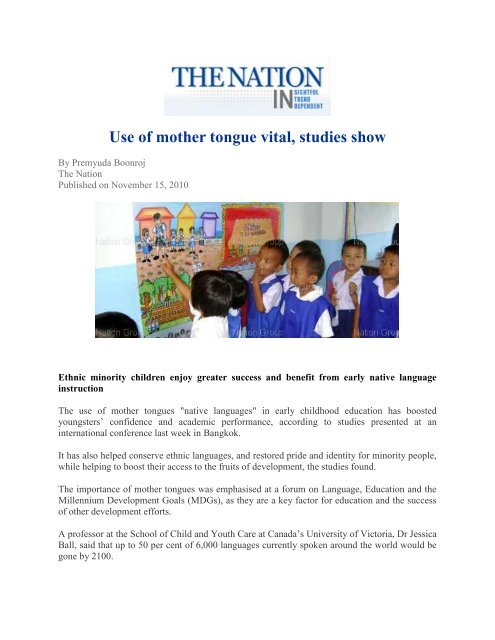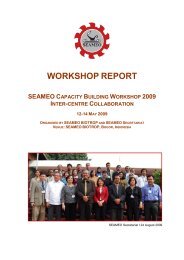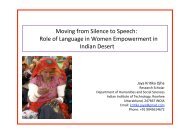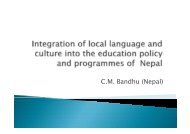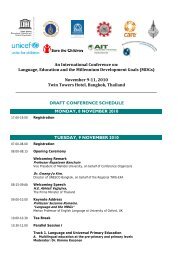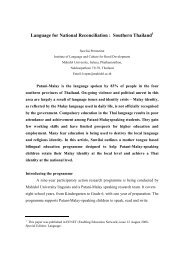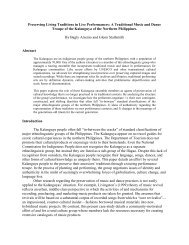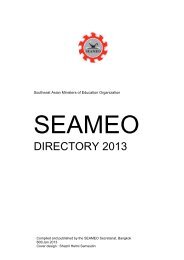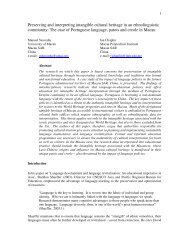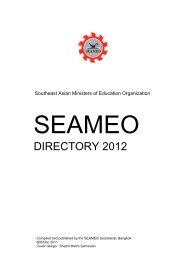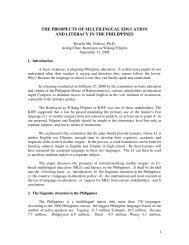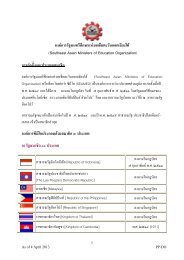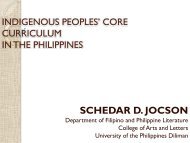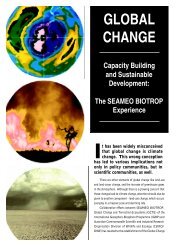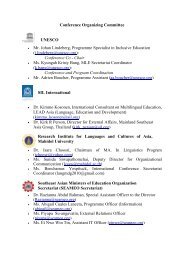"Use of mother tongue vital, studies show", 15 November 2010, The ...
"Use of mother tongue vital, studies show", 15 November 2010, The ...
"Use of mother tongue vital, studies show", 15 November 2010, The ...
Create successful ePaper yourself
Turn your PDF publications into a flip-book with our unique Google optimized e-Paper software.
<strong>Use</strong> <strong>of</strong> <strong>mother</strong> <strong>tongue</strong> <strong>vital</strong>, <strong>studies</strong> show<br />
By Premyuda Boonroj<br />
<strong>The</strong> Nation<br />
Published on <strong>November</strong> <strong>15</strong>, <strong>2010</strong><br />
Ethnic minority children enjoy greater success and benefit from early native language<br />
instruction<br />
<strong>The</strong> use <strong>of</strong> <strong>mother</strong> <strong>tongue</strong>s "native languages" in early childhood education has boosted<br />
youngsters’ confidence and academic performance, according to <strong>studies</strong> presented at an<br />
international conference last week in Bangkok.<br />
It has also helped conserve ethnic languages, and restored pride and identity for minority people,<br />
while helping to boost their access to the fruits <strong>of</strong> development, the <strong>studies</strong> found.<br />
<strong>The</strong> importance <strong>of</strong> <strong>mother</strong> <strong>tongue</strong>s was emphasised at a forum on Language, Education and the<br />
Millennium Development Goals (MDGs), as they are a key factor for education and the success<br />
<strong>of</strong> other development efforts.<br />
A pr<strong>of</strong>essor at the School <strong>of</strong> Child and Youth Care at Canada’s University <strong>of</strong> Victoria, Dr Jessica<br />
Ball, said that up to 50 per cent <strong>of</strong> 6,000 languages currently spoken around the world would be<br />
gone by 2100.
“One way to achieve equity in education, opportunities and [the goal <strong>of</strong>] Education For All, as<br />
well as to counter linguistic and cultural loss is to deliver early childhood education and primary<br />
education through <strong>mother</strong> <strong>tongue</strong>s,” she said.<br />
Various <strong>studies</strong> presented at the conference reaffirmed this.<br />
Linguistic expert Siripen Ungsitipoonporn, from Mahidol University’s Research Institute for<br />
Languages and Cultures <strong>of</strong> Asia, and Chiang Mai’s Ban Mai Neong Bua schoolteacher<br />
Kanyapak Arthan presented details about the success <strong>of</strong> using <strong>mother</strong> <strong>tongue</strong>s as a medium <strong>of</strong><br />
instruction to teach Yunnanese children. <strong>The</strong>y said children’s academic performances were<br />
rather low when they weren’t familiar with academic Thai used in the classroom.<br />
Children <strong>of</strong> YunnaneseChinese descent at Ban Mai Neong Bua School were no exception.<br />
Trying to use the children’s first language, Yunnanese Chinese, as a medium <strong>of</strong> instruction from<br />
kindergarten 1 onwards, the school found they had no qualified teachers who could speak<br />
Yunnanese, so teaching assistants who speak that language were trained to teach the children.<br />
Although the project only started in the first semester <strong>of</strong> <strong>2010</strong>, the home room Thai teacher<br />
Kanyapak and her assistant working in an experimental KG1 classroom saw that the children’s<br />
behaviour had changed for the better. <strong>The</strong>y were not afraid to come to school or express<br />
themselves as they had confidence in their language that their teachers also used, Kanyapak said.<br />
<strong>The</strong> kids also enjoyed learning and participating in class activities.<br />
kidS more eager to learn<br />
Older siblings <strong>of</strong> the students under this project also accepted their younger brothers/sisters’<br />
positive change and even volunteered to prepare teaching materials for the projects, she said. <strong>The</strong><br />
parents, who at first were worried their kids would face difficulty catching up with peers in<br />
reading and writing Thai, also responded positively after seeing their kids more eager to learn<br />
and talk to them a lot about what they had learnt, she said. Although the school lacks budget and<br />
resources, they weren’t discouraged and carried on the project the best they could, she said.<br />
Meanwhile, Save the Children coordinator Bonna Duron presented her group’s work in piloting<br />
Mother TongueBased Multilingual Education since 2007 in Mindanao’s South Cotabato and<br />
Sultan Kudarat provinces " where are at least three languages spoken " Tboli, Iionggo and<br />
Maguindanaoan.<br />
<strong>The</strong> Philippine educational system emphasised English and Filipino as the languages <strong>of</strong><br />
instruction and textbooks, regardless <strong>of</strong> a child’s background, she explained. But a policy shift in<br />
2009 opened the door for <strong>mother</strong> <strong>tongue</strong> based instruction in early primary years.<br />
To put the policy into action for kids nationwide, the agency in February 2009 also conducted<br />
preliminary activities including a formative research on language perception and use in<br />
communities, a formation <strong>of</strong> Language Advisory Committees at the regional/community levels<br />
and other activities to raise awareness and prepare communities. <strong>The</strong>y organised teacher training
on curriculum adaptation and materials development, as well as making “culturallyappropriate”<br />
teaching materials such as alphabet primers, alphabet charts and books in the three languages.<br />
In Cambodia, a study on ethnic Cham children in Kampong Cham by Save the Children Sweden<br />
and the Kampuchean Action for Primary Education (KAPE) was presented by KAPE <strong>of</strong>ficial<br />
Kurt Bredenburg.<br />
<strong>The</strong> study revealed Cham people’s complex attitudes towards mainstream Cambodian society as<br />
they wanted to blend in rather than being seen as an ethnic minority or as Islamic Khmers. But<br />
they <strong>of</strong>ten chose not to live in Khmer villages and not to speak Khmer as their first language.<br />
Since the Cham language and Islam weren’t available in state schools, an Islamic school system<br />
emerged to run in parallel. So most kids attended state schools in the morning and early<br />
afternoon, then went to the Islamic schools in late afternoon or weekend, the study found.<br />
KAPE’s “Minority Outreach in Education” pilot project, has been implemented for two years, to<br />
try to increase educational relevance for populations with a large number <strong>of</strong> Cham and work<br />
towards universal primary education.


